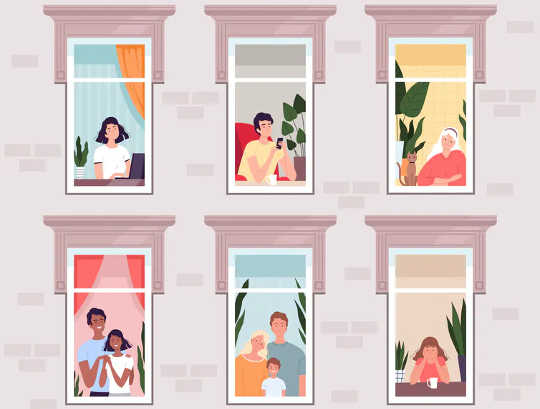
If we think it’s normal to stick to the rules and doing so is in the collective good, then we’re less likely to muck up. www.shutterstock.com
When we hear of people who have allegedly escaped from mandatory quarantine — whether that’s from hotels in Perth, Toowoomba, Sydney or Auckland — it’s easy to ask: “What were they thinking? Why didn’t they just follow the rules?”.
But our recent review shows people are less likely to follow public health advice if they misunderstand, or have negative attitudes towards it.
The challenge is that while COVID-19 has been with us since the beginning of the year, we still may not necessarily know someone in our close networks who has been in quarantine. We may be relying on a deluge of misinformation about it from the media, or social media.
So how can we use our knowledge of human behaviour to better support people complying with quarantine?
Which factors affect what we think about quarantine?
We reviewed the range of factors that influence people’s engagement or compliance with COVID-19 public health advice, such as quarantine. These included:
-
perceptions around the rationale and effectiveness of quarantine
-
perceived consequences of complying (or not)
-
perceptions about the level of community and personal risk from COVID-19
-
having enough basic supplies (for instance, food, water, clothes).
Gender, age, marital status, professional status and education level also played a role in whether people complied, but clearly, these cannot be modified.
The facts are important, but so are emotions
Our review found one of the major factors affecting people’s likelihood to comply with quarantine is their knowledge about COVID-19, how the virus is transmitted, symptoms of infection, and quarantine protocols.
Not understanding what quarantine means and its purpose may lead to people inventing their own rules, based on what they think is an acceptable degree of contact or risk.
Perhaps not too surprising, if we believe quarantine is beneficial, then we are more likely to follow the rules. However, providing people with merely factual information may not be the answer. We need to engage with people’s emotions too.
Emotions can influence our perception of risk, sometimes more so than factual information. For example, we often hear about the negative experiences of quarantine or self-isolation, but often not the positive frame, for instance the number of people who have successfully complied. This helps normalise quarantine, and make people more likely to copy the expected behaviour.
Social norms play an important role. If people believe there is a collective commitment to protect the community from further spread of infection, they are more likely to respect the public health measure. An individual’s participation can be conditional on whether they think others are also contributing.
However, social norms can also have the opposite effect. If people think others are breaking the quarantine rules, they may follow suit.
Concerns about stigma or discrimination can also impact a person’s willingness to comply with quarantine. Stigma can make people more likely to hide symptoms or illness, keep them from seeking health care immediately, and prevent people from adopting healthy behaviours.
Lastly, people may push back against the regulations as a way of retaining a feeling of control. They may push back because they are stressed or anxious, which in turn affects how they think about the issue or how they make decisions.
So how do we use this?
To support acceptance of and community compliance with quarantine, we need to take these behavioural issues into account. We need to:
1. prepare people for what they might experience: boredom, loss of freedom or routine, irritability and/or anxiety. Priming people may help them think about ways to reduce these issues
2. encourage people to make plans as we know this helps people cope. Encouraging people to stick to similar (pre-quarantine) routines may help people avoid getting anxious or stressed. These plans need to be time-specific and intentional, not aspirational. For instance, we could encourage people to structure time for exercise and for virtual socialising. Others have suggested doing shared activities, such as watching a movie on Netflix at the same time
3. provide access to social, pyschological and medical support whether that’s via reliable internet access or access to helplines
4. provide adequate basic supplies such as food, water and clothes, and a safe and clean place to quarantine
5. encourage our leaders to clearly articulate, and others to reinforce, that complying with quarantine is in our group interest and it’s expected people will pull their weight. And if they don’t, this won’t be acceptable
6. provide media coverage that reflects the fact most people comply. Examples of people who run away from quarantine clearly represent quarantine failures, but they are outliers. Perhaps its time to look at the proportion of people who have complied with hotel quarantine as we need to establish the collective norm is to comply
7. provide people with adequate sick leave and other structural supports, such as the ability to work remotely, alongside any solutions supporting behaviour change.![]()
About the Author
Holly Seale, Senior Lecturer, UNSW
This article is republished from The Conversation under a Creative Commons license. Read the original article.

Related Books:
Atomic Habits: An Easy & Proven Way to Build Good Habits & Break Bad Ones
by James Clear
Atomic Habits provides practical advice for developing good habits and breaking bad ones, based on scientific research on behavior change.
Click for more info or to order
The Four Tendencies: The Indispensable Personality Profiles That Reveal How to Make Your Life Better (and Other People's Lives Better, Too)
by Gretchen Rubin
The Four Tendencies identifies four personality types and explains how understanding your own tendencies can help you improve your relationships, work habits, and overall happiness.
Click for more info or to order
Think Again: The Power of Knowing What You Don't Know
by Adam Grant
Think Again explores how people can change their minds and attitudes, and offers strategies for improving critical thinking and decision making.
Click for more info or to order
The Body Keeps the Score: Brain, Mind, and Body in the Healing of Trauma
by Bessel van der Kolk
The Body Keeps the Score discusses the connection between trauma and physical health, and offers insights into how trauma can be treated and healed.
Click for more info or to order
The Psychology of Money: Timeless lessons on wealth, greed, and happiness
by Morgan Housel
The Psychology of Money examines the ways in which our attitudes and behaviors around money can shape our financial success and overall well-being.


 Shutterstock
Shutterstock




















